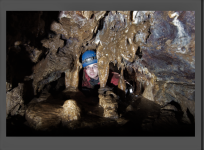Occasionally I choose to shoot RAW. For 95% of the time I have a camera in my hand it is Jpeg (Super Fine). You're right that RAW gives you more, but what if you don't need more? Capturing the scene or action with a straight out of camera Jpeg is a skill in itself, but more importantly for me, does not slave me to image editing. If I get a Jpeg home to find that it is a little burnt out or the colours are not quite as I want them to be, I can edit that Jpeg just fine.
Example of one I took yesterday as a Jpeg and I gave a little colour tweak and exposure shift in Olympus Workspace:
 9-8-2020 (10)
9-8-2020 (10) by
Pete Knight, on Flickr
Click through if you want to see it at full res. Maybe 1 in every 200 pics on my Flickr started life as a RAW. Be warned, it's not all caving pics, I'm becoming a bit of wildlife guy!
And to make the point about editing non-RAW files further, I took the overexposed PNG of the Pearly Gates from above (screengrabbed) and adjusted the light levels using Microsoft Photos App in 10 seconds. It looks very similar to the edited one on the right in the post. I fully admit that if I was printing that pic in higher resolution in a magazine it could be better, but for those of us content to show our work on social media and the occasional slideshow, Jpegs are more than adequate. If I need to print and/or maintain the highest range of colour and depth then RAW it is, but for most of us who who don't publish this is not an issue.
RAW is ace when you need it, Jpeg is fine when you don't. One is not better than the other, either is appropriate for a particular person. I know Phil shoots in RAW and his work is superb. I imagine the editing is part of the joy of the journey for him though being the artist that he is. It's not there for me yet. A quick shadow tweek or crop on a Jpeg in Olympus Workspace is about as much as I want to spend time doing. Most times I'm happy to stick things online straight out of the camera, even if RAW might have got me a bit more dynamic range. If it looks good to me I'm happy with that.
I find that lots of photographic discussions seem to degenerate into a must use RAW or you're an amateur type conversation, and I just think it makes photography seem more out of reach (and dare I say pretentious) to those who might otherwise be inspired to take it up.
Snap in RAW, snap in Jpeg, whatever suits you. Neither is best for all. There are people on here who are far more accomplished photographers than me and I do not claim to be in the remotest bit competent about the technicalities of photography. Like OR, I'm just happy to take a pic and enjoy it, but I totally understand the editing process is important and fun for others.
I've just started shooting RAW+Jpeg now my new camera has 2 card slots, so we'll see what that does to my opinion in future!
Anyway, I think we've gone a mile from AI and computational photography.









